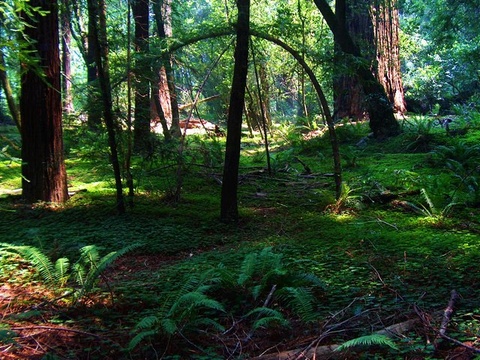Wood Ferns are members of the Cysopteris, Dryopteris, and Polystichum genera in the wood fern family. Many of them are native to the Yuba-Sutter area.
Brittle Bladderfern
Brittle bladderfern (also called fragile fern) is a six- to twelve-inch-tall, drought-deciduous wood fern that is native to Yuba and Sutter Counties and typically grows at elevations below 12,000 feet. It is most often found in moist rock crevices in central oak woodland, valley grassland, or yellow pine forest. It prefers full shade.
You can read more about it at the Theodore Payne Wiki. You can see pictures of it at CalPhotos, Flickr, and Picasa. You can find out where to buy it at the California Native Plant Link Exchange.
Coastal Wood Fern
Coastal wood fern (also called shield fern) is a three-foot-tall by three-foot-wide, stress-deciduous wood fern that is native to Yuba and Sutter Counties and typically grows at elevations below 6,000 feet. It is most often found on wooded slopes. It prefers full shade.
You can read more about it at the Theodore Payne Wiki and the Las Pilitas Nursery website. You can see pictures of it at CalPhotos, Flickr, and Picasa. You can find out where to buy it at the California Native Plant Link Exchange.
Western Swordfern
 Western swordferns (Polystichum munitum) in a redwood forest. Photo by queerbychoice. Western swordfern is a two- to four-foot-tall by two- to five-foot-wide, evergreen wood fern that is native to Yuba County and typically grows at elevations below 7,000 feet. It is most often found on slopes in yellow pine forest. It prefers full shade.
Western swordferns (Polystichum munitum) in a redwood forest. Photo by queerbychoice. Western swordfern is a two- to four-foot-tall by two- to five-foot-wide, evergreen wood fern that is native to Yuba County and typically grows at elevations below 7,000 feet. It is most often found on slopes in yellow pine forest. It prefers full shade.
You can read more about it at the Theodore Payne Wiki and the Las Pilitas Nursery website and USDA Conservation Plant Characteristics. You can see pictures of it at CalPhotos, Flickr, and Picasa. You can find out where to buy it at the California Native Plant Link Exchange.
Narrowleaf Swordfern
Narrowleaf swordfern (also called cliff sword fern) is a wood fern that is native to Yuba County and typically grows at elevations between 1,000 and 8,000 feet. It prefers full shade.
You can see pictures of it at CalPhotos, Flickr, and Picasa. You can find out where to buy it at the California Native Plant Link Exchange.


